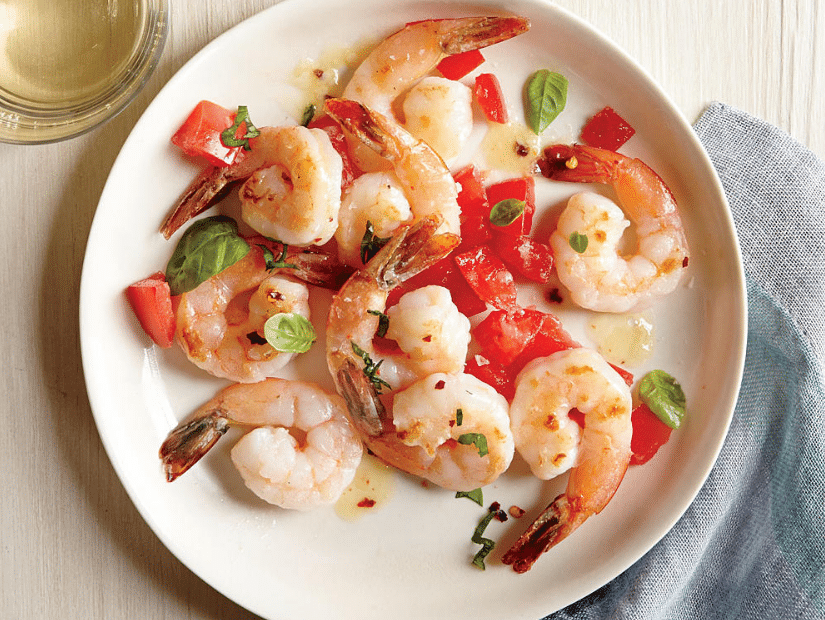Calories in Shrimp: Shrimp cocktail is on practically every holiday menu, but many of my clients aren’t sure if they should avoid shrimp or dig in.
If you’re a seafood eater and you enjoy these crustaceans, either chilled or in hot dishes, here are seven things you should know.

They’re low in calories
One medium shrimp provides about 7 calories, which means a dozen add up to less than 85 calories—roughly 15 less than a 3-ounce chicken breast (about the size of a deck of cards in thickness and width). One jumbo shrimp, the type often served in shrimp cocktail, contains about 14 calories, and a teaspoon of cocktail sauce provides 5, so three jumbo shrimp, each with a teaspoon of cocktail sauce as an appetizer, add up to less than 60 calories, about 10 less than just one pig in a blanket, and 20 less than two mini empanadas or two mini quiches.

They’re protein-rich
In addition to their water content, shrimp are primarily made of protein. Three ounces of baked or broiled shrimp provides about 20 grams of protein, just a few grams less than that of a 3-ounce chicken breast. Each jumbo shrimp provides about 3 grams and contains very little fat and carbohydrate.
They provide key nutrients
Aside from protein, shrimp provide a pretty impressive array of nutrients. Four ounces steamed contains over 100% of the Daily Value for selenium, over 75% for vitamin B12, over 50% for phosphorous, and over 30% for choline, copper, and iodine. And while we don’t typically think of animal proteins as sources of antioxidants, shrimp contain two types. In addition to being a mineral that plays a role in immunity and thyroid function, selenium is an important antioxidant that helps fight damaging particles called free radicals, which damage cell membranes and DNA, leading to premature aging and disease. Another antioxidant, called astaxanthin, which provides the primary color pigment in shrimp, has been shown to help reduce inflammation, a known trigger of aging and disease
They’re a common allergen
As a member of the shellfish family, shrimp are among the top allergens, which in addition to shellfish include milk, eggs, fish, tree nuts, peanuts, wheat, and soy. Exposure to shrimp by those who are allergic to shellfish can cause a severe reaction, including life-threatening anaphylaxis. More mild reactions may include a stuffy nose, sneezing, itchy skin, hives, tingling in the mouth, abdominal pain, and nausea. A food allergy can develop at any age. If you think you may be allergic to shrimp, or any other food, see an allergist for testing right away.
Yes, they’re high in cholesterol, but…
The current guidelines from both the USDA and American Heart Association state that dietary cholesterol intake should be limited to no more than 300 mg per day and three ounces of shrimp provide about half that amount. There are two kinds of cholesterol. The first is called dietary cholesterol, which is the cholesterol found in foods. Only foods from animals contain cholesterol because the animals’ bodies produced it. The second kind of cholesterol is blood or serum cholesterol: this is the cholesterol inside of your body. Blood cholesterol is produced by your liver and released into your bloodstream.
If you eat animal-based foods, the cholesterol you absorb can also contribute to blood cholesterol. However, the impact of dietary cholesterol on blood cholesterol has been an issue of debate. Research shows that high intakes of saturated fat and man-made trans fat have the greatest impact on blood cholesterol. Shrimp is very low in saturated fat and doesn’t contain trans fat—unless it’s been fried or cooked in a way that adds trans fat. But if you already have high cholesterol, follow the advice of your doctor about dietary cholesterol. And for more on how to eat seafood healthfully, check out my previous post on 5 Healthy Cooking Tips for Fish.
Shrimp fraud is common
A recent report from Oceana found that 30% of 143 shrimp products tested from 111 nationwide vendors were misrepresented. For example, farmed shrimp was sold as wild or Gulf. This means you may be unknowingly eating shrimp produced in a farm that uses antibiotics, fungicides, and other harmful chemicals. Unfortunately there isn’t much you as a consumer can do about this, but for more info about choosing shrimp that is properly labeled, checkout out this handy resource from Seafood Watch.
Even wild shrimp may contain contaminants
A recent Arizona State University study analyzed 27 samples of seafood, including shrimp, from 11 countries. Researchers found detectable amounts of five different antibiotics, including in wild shrimp. This is a critical finding since the use of antibiotics in food production has contributed to a rise in antibiotic-resistant bacteria, a major public health concern.
Bottom line: nutritionally speaking, shrimp is a bit of mixed bag, and Americans eat more shrimp than any other seafood item. If you’re one of them the best advice is to know the pros and cons, enjoy shrimp in moderation, and do your best to shop for, prepare, and order the healthiest options. For more info check out 5 Rules for Buying and Storing Seafood.
Is Shrimp Healthy For Weight Loss?
How Many Calories Are In 10 Jumbo Shrimp?
How Many Calories In Shrimp?
It is quite low in calories, providing only 84 calories in a 3-ounce (85-gram) serving, and does not contain any carbs. Approximately 90% of the calories in shrimp come from protein, and the rest come from fat (1).